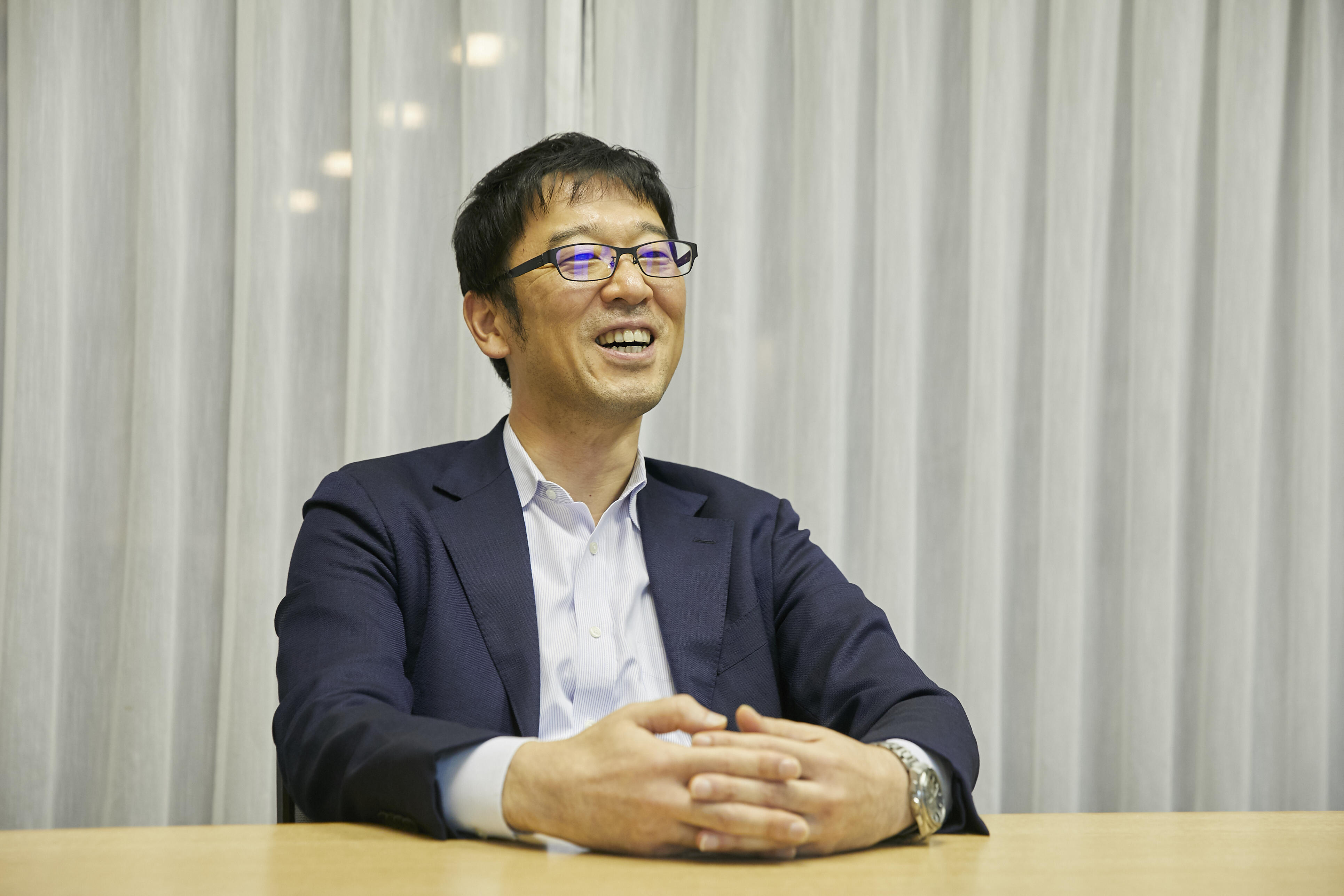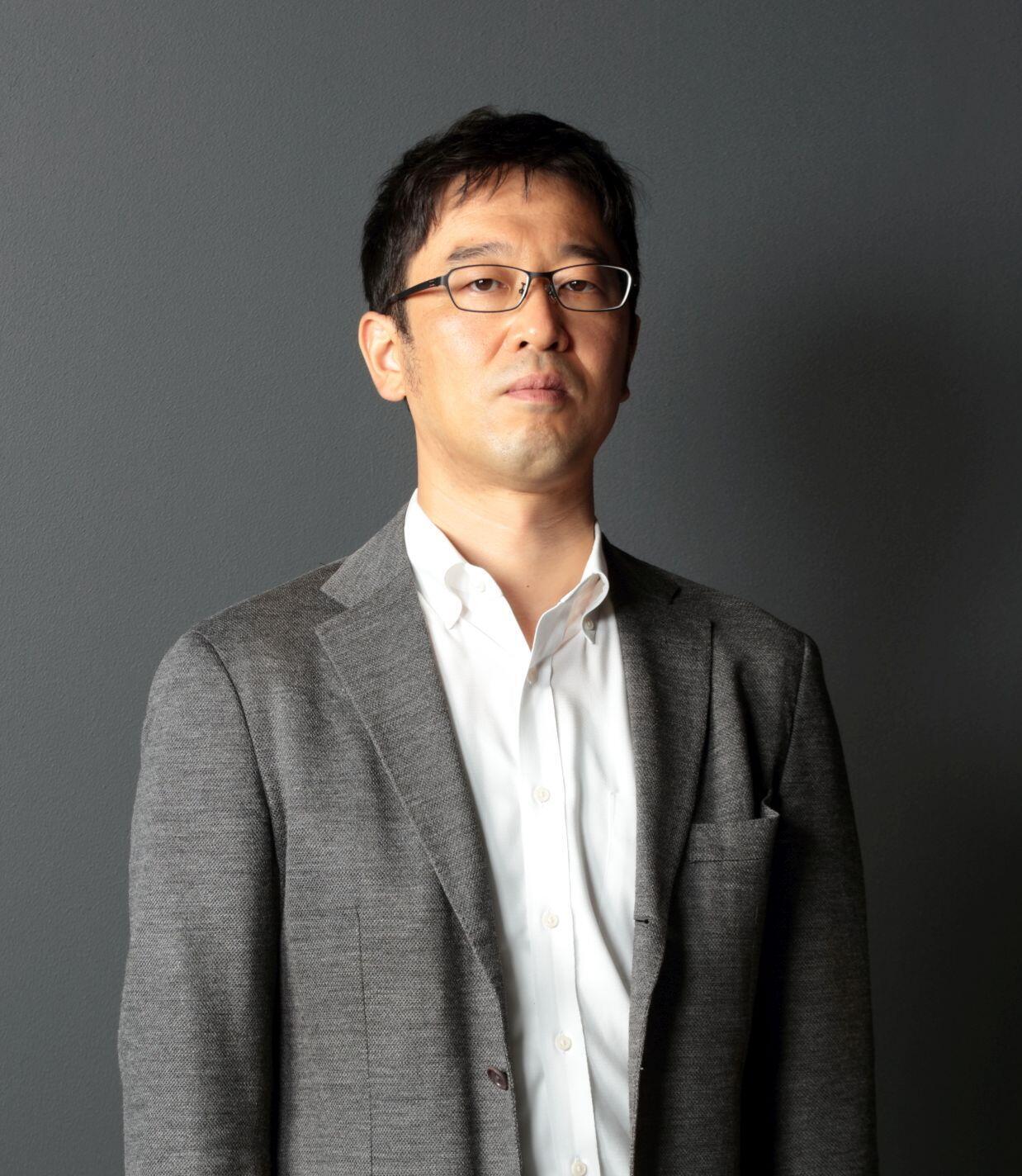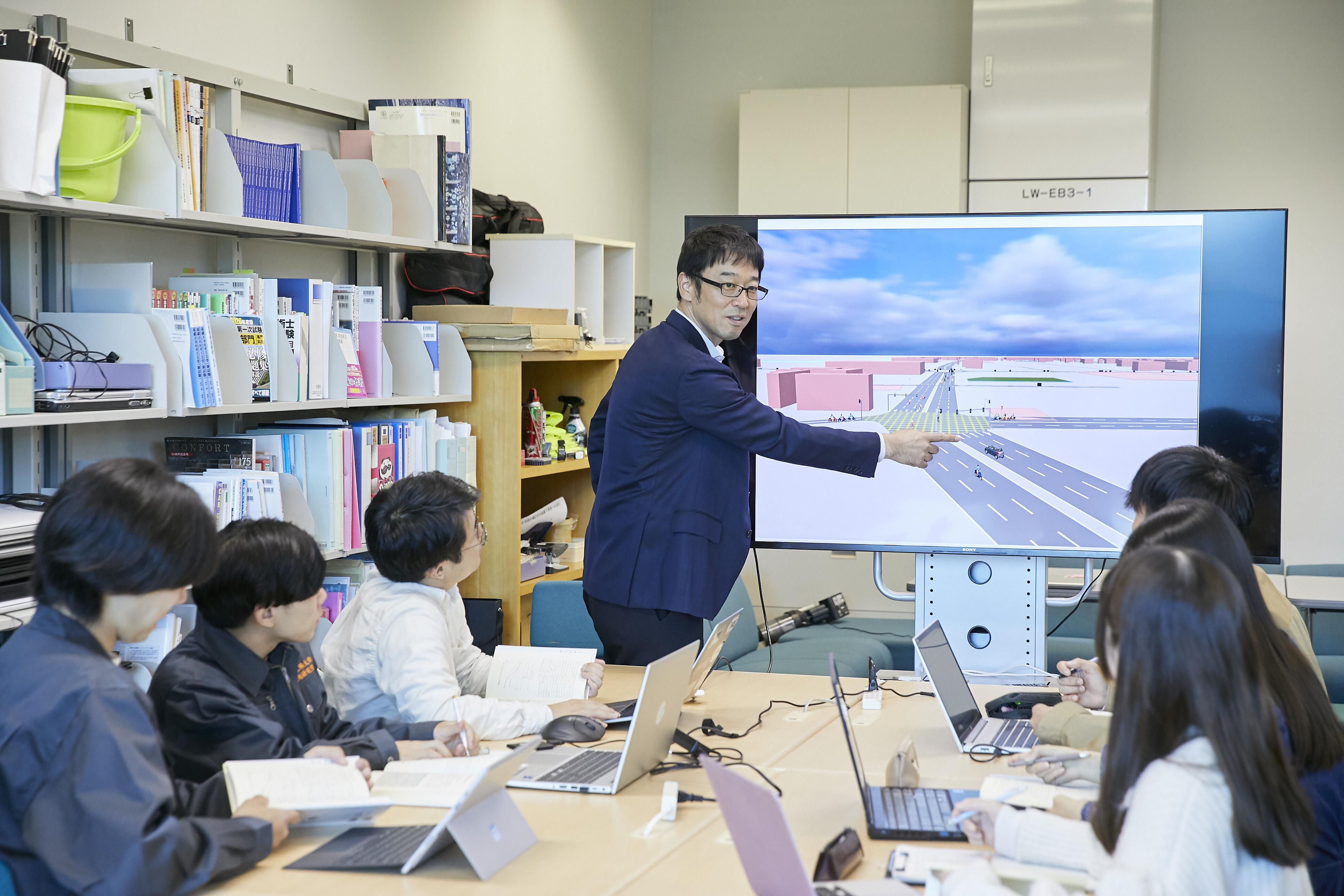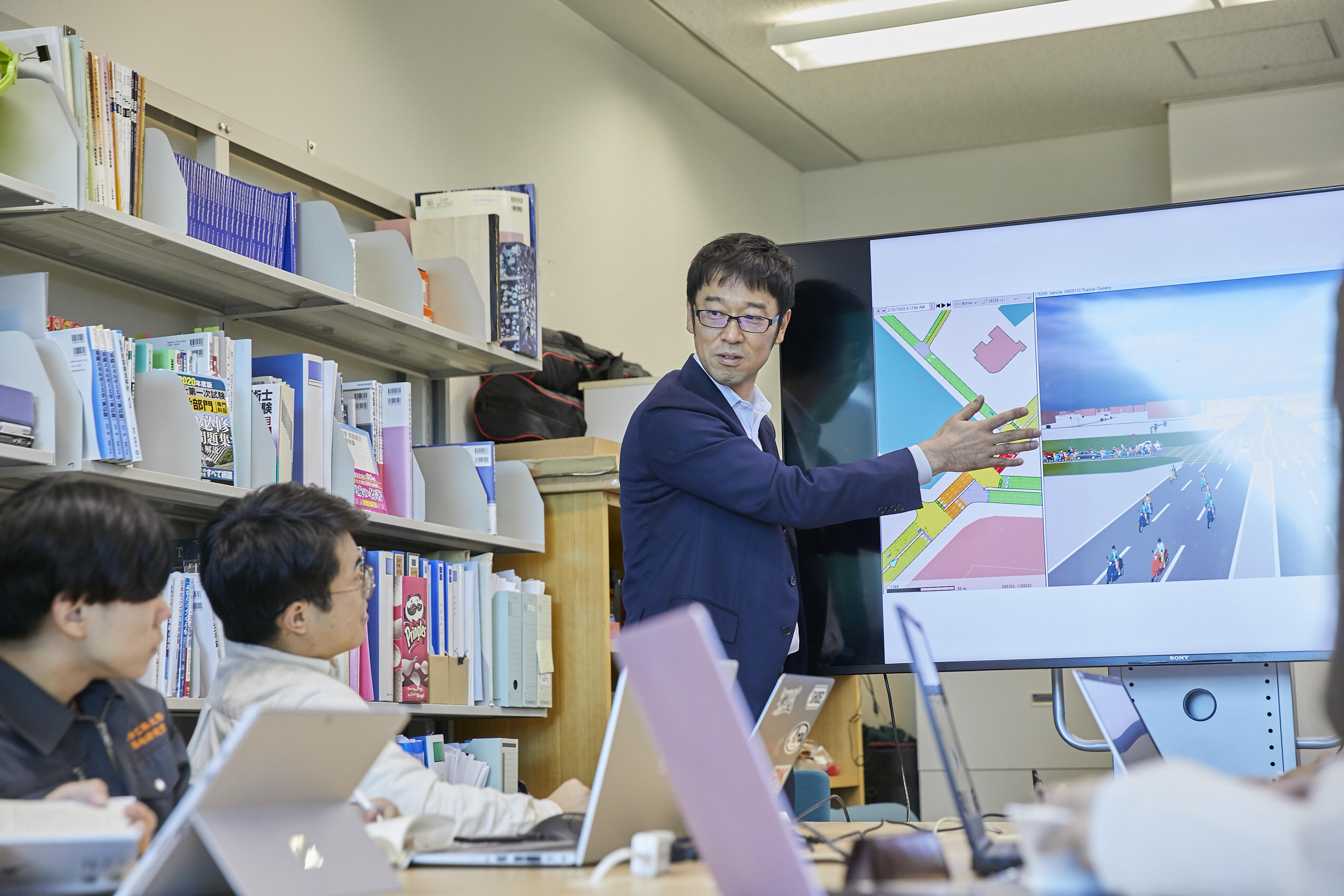- TOP
- Cutting-edge Research and Social Contribution
- Cutting-edge Research
- For the children who are the future of regional cities. Tackling the challenge of realizing a sustainable future-generation transportation network

For the children who are the future of regional cities. Tackling the challenge of realizing a sustainable future-generation transportation network

NISHIUCHI Hiroaki
- Specialized field
Infrastructure Planning and Management, Traffic Engineering
Transportation-related problems are becoming increasingly apparent in Japan against a backdrop of declining birth rates, an aging population, and population decline. Particularly in regional cities where life cannot function without cars, difficulties in maintaining services have arisen due to a decline in users of public transportation, in addition to road traffic problems such as traffic jams and accidents. Building a sustainable transportation system is a crucial element for maintaining people's quality of life and regional revitalization.
Professor Hiroaki Nishiuchi, who specializes in transportation engineering, is conducting research on the best approaches to transportation systems, with an eye to the future in regional cities facing these challenges.
He wants to provide children with road space as a place to play
Professor Nishiuchi first focused on securing safe and secure transportation spaces for the future to protect children from traffic accidents. According to a survey conducted by Professor Nishiuchi and his team in Kochi Prefecture, they found that there was almost no difference in vehicle speeds between major roads and residential streets, highlighting the current situation where the distinction between different types of roads has become blurred.
"Particularly on residential streets, we found many cases where local residents speed through on shortcuts or engage in dangerous behavior due to familiarity with an area, revealing high risks of traffic accidents."
He points out that the deeply rooted driver mentality of "cars have priority" is closely linked with this issue.
Professor Nishiuchi, who keenly felt the need to reduce traffic functions on residential streets and reallocate road space with pedestrian safety as the top priority, has been exploring ways to improve pedestrian traffic functions through policy/behavioral measures that utilize existing road space rather than large-scale infrastructure development.
"By accumulating evidence that vehicles must travel more safely on school routes, I want to move toward the recommendation that we need to consider school route management. Right now, I am conducting basic research for that purpose."
The analysis results showed that children's walking spaces tend to show more variation when coming home from school than going to school, with higher risks of sudden darting out and crossing. It also became clear that children have narrow fields of vision and walk without being sufficiently aware of their surroundings.
"Using these findings, I want to consider a system that can detect in real time the street sections and time periods where changes in children's walking behavior can occur, allowing dangerous situations to be avoided. Another thing I particularly want to do is regulate vehicle traffic in those sections and time periods to secure road space as a 'place to play.' While some areas in the Tokyo metropolitan region have introduced such initiatives, I think we should consider implementing this locally as well."
In regional cities experiencing population decline, protecting and nurturing children is a particularly important theme. Professor Nishiuchi's efforts to enable children to use roads with peace of mind will help support the future of those communities.

Exploring public transportation services attractive to the young generation through research and practice
Public transportation is a key alternative means of transport to replace cars in order to move away from a car-based society. However, Professor Nishiuchi emphasizes, "In Kochi Prefecture, particularly in hilly and mountainous areas, children and the younger generation have no opportunities to ride public transportation. That is precisely why I am conducting research from a perspective focused on children."
"While we saw the completely natural psychology of people not buying expensive things, what I found really interesting was that as prices increase, purchasers' usage frequency also increases. In other words, we were able to confirm that when flat-rate services are introduced, people try to get their money's worth. On the other hand, we also found that use increases even when prices are at their lowest. Furthermore, it became clear that introducing this service could potentially attract about 20% of people who do not normally use public transportation."
"When we showed these results to public transportation operators, we received positive feedback such as proposals to create a common system through collaboration with bus companies that run parallel to railway lines. I hope we can make Kochi's public transportation increasingly interesting for children in this way."
"Seeing the posts that the high school student monitors uploaded to Instagram, members of the general public showed their support, and I think this initiative led to increased awareness of public transportation in the Reihoku region. On the other hand, in carrying out this practical initiative, we received a great deal of cooperation, such as JR Shikoku revising their schedule so that express trains would stop at the nearest Osugi Station, and Reihoku Kanko coordinating bus times with express and local trains. Thanks to these efforts, we learned well that even in mountainous areas like Reihoku, seamless public transportation services can be provided by utilizing what already exists. From these research and practical experiences, I realized that by making public transportation seamless in Kochi as well, young people might also take an interest. I hope to conduct further new research toward realizing this."
Analyzing user behavior based on smart card data, to implement AI-driven marketing measures
"Actually, Kochi's transportation data is quite comprehensive, and it's likely unusual worldwide for smart card data to be recorded in the same system for over 14 years. Using this long-term data, I want not only to understand user behavior patterns but also to create AI models based on smart cards and connect this to analysis of all kinds of transportation behavior."
From 2022 to 2023, "One Coin Day" was implemented, where using an smart card reduced streetcar and bus fares to 10 yen. When the effects of this policy were analyzed from the data, it was confirmed that groups who had not been using transportation before the discount began use as a result of the policy and continued use for a certain period afterward. In other words, it became clear that a certain number of people exist who will use transportation when fares become cheaper and they can get a sense of value, suggesting that implementing discount policies influences the promotion of public transportation use.
"For example, we could individually display messages like 'Your next ride will be half price' when someone touches their smart card to the fare box. I would like to create a system where AI determines fares to suit individual users and consider marketing programs to prevent people from stopping their use."
Aiming to build sustainable transportation systems for the future
"Transportation engineering is an academic field studied worldwide, but I think there probably isn't much research like ours that considers the best approaches to future of road space and public transportation on the premise that regional cities are shrinking. Using data obtained, precisely because we are in a prefecture at the forefront of such challenges, to carry out analysis and gain new insights is something that can only be achieved by doing research in Kochi.
Also, in comparison with urban areas, we in Kochi are close to transportation stakeholders and can immediately report when research results emerge. Sometimes this leads to practical implementation. The fact that research directly connects to practical work is both the reward and the interesting aspect of conducting transportation research in Kochi."
"I think all Kochi Prefecture residents should recognize that public transportation is for all people, including the transportation-disadvantaged, children, and the young generation. Looking toward the future, I want to provide mobility options to children and the young generation and have them fully recognize these options. To achieve this, I want to seamlessly integrate our road space and public transportation research, create a vision for a new-generation transportation network, and take a step toward realizing sustainable transportation systems."

Date of posting: June, 2025/ Date of interview: November, 2024
